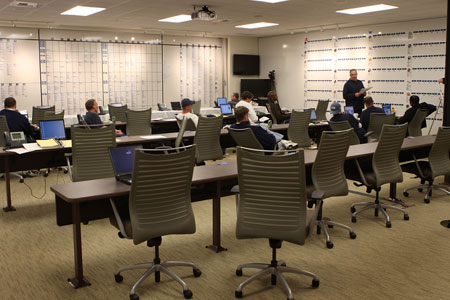The Story of Garrett Jones
The Minnesota Twins have a well-deserved reputation as an organization that knows how to judge talent, to select, train, and consistently produce a steady stream of high quality players. This organizational capability to find and develop so-called 'home-grown' talent is critical for a team like the Twins, who historically have had significantly lower salary budgets than many of their rivals like the Yankees and Red Sox.
Some of the top players that have been brought through the Twins system past American league Most Valuable Players Joe Mauer and Justin Morneau, as well as pitching great Johan Santana (now currently playing for the Mets). By consistently making smart draft choices, having a consistent philosophical approach that is embedded throughout all levels of the organization, and by actually providing real opportunity for these home-grown players at the major league level, the Twins are contenders for the division and league title most years. They are in a way a kind of baseball version of the NBA's Utah Jazz, my friend the HR Capitalist's favorite team.
With that background, I want to share a bit of the story of Garrett Jones, an outfielder now playing in  the major league for the Pittsburgh Pirates, ( a team I took a shot at recently). Fans of the Pirates certainly, know some of Jones' story. A player with 10-plus seasons toiling at various levels of baseball's minor league system, never really getting much of a chance to see if he had what it took to succeed in the big leagues. In fact, Jones was in the minor leagues for so long, a little known baseball rule called the 6-year free agent rule, granted him his release from the club that owned his contract late in 2008 and allowed him to sign with the Pirates organization.
the major league for the Pittsburgh Pirates, ( a team I took a shot at recently). Fans of the Pirates certainly, know some of Jones' story. A player with 10-plus seasons toiling at various levels of baseball's minor league system, never really getting much of a chance to see if he had what it took to succeed in the big leagues. In fact, Jones was in the minor leagues for so long, a little known baseball rule called the 6-year free agent rule, granted him his release from the club that owned his contract late in 2008 and allowed him to sign with the Pirates organization.
The club that 'owned' Jones for the 6-plus years?
The Twins.
One of the primary reasons Jones never got much of a chance with the Twins (about 30 games in 2007), was the presence of the star Morneau, who played the same position as Jones, as was one of the games best players. To be fair, Jones' minor league career did have some down points as well, so the Twins could also be forgiven for having some doubts about his upside.
Jones began the 2009 season once again in the minor leagues, but about halfway through the season, he was called up to the Pirates and proceeded to have an outstanding second half. Jones hit 21 home runs and batted nearly .300. For a perennial losing team like the Pirates, this performance was likely the highlight of the (sorry) season. This year in the new season's first three games, Jones has already hit three home runs.
The point of all this to me is that even organizations that pride themselves as great evaluators and developers of talent sometimes get one wrong. Jones was plying his trade for the organization for many years, in fact for so long league rules allowed him to break away, and the Twins for whatever reason did not or could not give Jones the chance to prove himself at the highest level, helping both the team's fortunes, as well as improving Jones' career prospects. Professional sports, and the individual performance of the players themselves, are so closely monitored, scrutinized, and evaluated, that these kind of talent 'misses' are relatively rare. Performance in sports is so measurable and public, that players possessing major league talent usually do end up in the major leagues. Maybe Jones simply needed a change of scenery to really display his true ability, but in the end, at almost 30 years old, he is much the same player the Twins did not give much of a chance to.
Think of it, someone spends more than six years working for the organization, their performance, development, and potential on display in the most visible manner possible, and yet the organization (universally regarded as great talent evaluators) allows the player to leave, only to see him star for another team.
Maybe the Twins did not think Jones had the 'look' of a major leaguer or the talent ahead of him in the organization was clearly superior, whatever the reason his talents were not recognized. But finally getting his chance with another team, he is turning in to a star.
I wonder if you look at the people in your organization right now, could you find similar untapped potential?
Are there people toiling away, solid performers, but not stars, maybe because they have not been given a big challenge, a lead role, or a big stage?
Will they eventually leave and hit the big time with one of your competitors?
Nah, you are a great talent evaluator, I am sure you have everyone pegged just right.

 Steve
Steve


